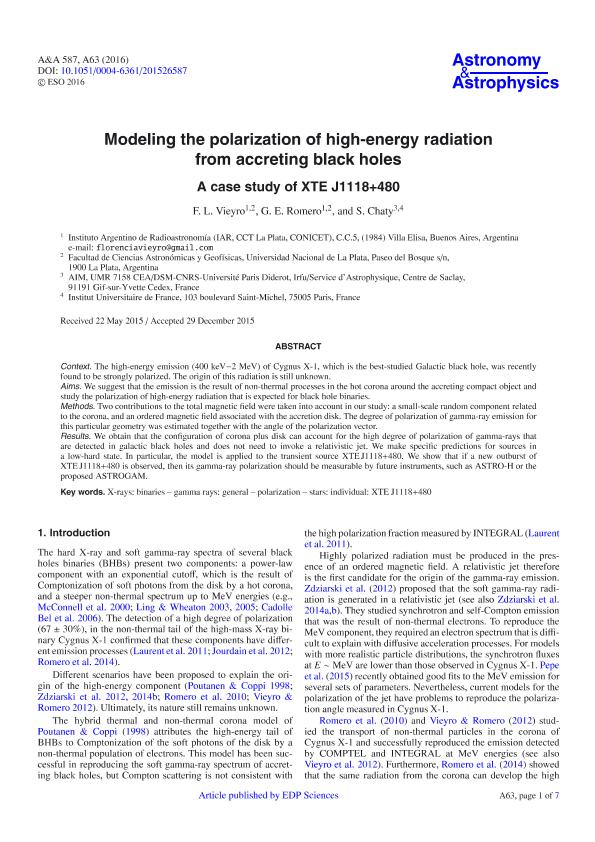Mostrar el registro sencillo del ítem
dc.contributor.author
Vieyro, Florencia Laura

dc.contributor.author
Romero, Gustavo Esteban

dc.contributor.author
Chaty, S.
dc.date.available
2017-06-05T15:38:30Z
dc.date.issued
2016-03
dc.identifier.citation
Vieyro, Florencia Laura; Romero, Gustavo Esteban; Chaty, S.; Modeling the polarization of high-energy radiation from accreting black holes: A case study of XTE J1118+480; Edp Sciences; Astronomy And Astrophysics; 587; 3-2016; 1-7;63
dc.identifier.issn
0004-6361
dc.identifier.uri
http://hdl.handle.net/11336/17475
dc.description.abstract
Context. The high-energy emission (400 keV-2 MeV) of Cygnus X-1, which is the best-studied Galactic black hole, was recently found to be strongly polarized. The origin of this radiation is still unknown. Aims. We suggest that the emission is the result of non-thermal processes in the hot corona around the accreting compact object and study the polarization of high-energy radiation that is expected for black hole binaries. Methods. Two contributions to the total magnetic field were taken into account in our study: a small-scale random component related to the corona, and an ordered magnetic field associated with the accretion disk. The degree of polarization of gamma-ray emission for this particular geometry was estimated together with the angle of the polarization vector. Results. We obtain that the configuration of corona plus disk can account for the high degree of polarization of gamma-rays that are detected in galactic black holes and does not need to invoke a relativistic jet. We make specific predictions for sources in a low-hard state. In particular, the model is applied to the transient source XTE J1118+480. We show that if a new outburst of XTE J1118+480 is observed, then its gamma-ray polarization should be measurable by future instruments, such as ASTRO-H or the proposed ASTROGAM.
dc.format
application/pdf
dc.language.iso
eng
dc.publisher
Edp Sciences

dc.rights
info:eu-repo/semantics/openAccess
dc.rights.uri
https://creativecommons.org/licenses/by-nc-sa/2.5/ar/
dc.subject
Gamma Rays: General
dc.subject
Polarization
dc.subject
Stars: Individual: Xte J1118+480
dc.subject
X-Rays: Binaries
dc.subject.classification
Astronomía

dc.subject.classification
Ciencias Físicas

dc.subject.classification
CIENCIAS NATURALES Y EXACTAS

dc.title
Modeling the polarization of high-energy radiation from accreting black holes: A case study of XTE J1118+480
dc.type
info:eu-repo/semantics/article
dc.type
info:ar-repo/semantics/artículo
dc.type
info:eu-repo/semantics/publishedVersion
dc.date.updated
2017-06-05T14:47:46Z
dc.journal.volume
587
dc.journal.pagination
1-7;63
dc.journal.pais
Francia

dc.description.fil
Fil: Vieyro, Florencia Laura. Provincia de Buenos Aires. Gobernación. Comision de Investigaciones Científicas. Instituto Argentino de Radioastronomía. Consejo Nacional de Investigaciones Científicas y Técnicas. Centro Científico Tecnológico Conicet - la Plata. Instituto Argentino de Radioastronomia; Argentina. Universidad Nacional de la Plata; Argentina
dc.description.fil
Fil: Romero, Gustavo Esteban. Provincia de Buenos Aires. Gobernación. Comision de Investigaciones Científicas. Instituto Argentino de Radioastronomía. Consejo Nacional de Investigaciones Científicas y Técnicas. Centro Científico Tecnológico Conicet - la Plata. Instituto Argentino de Radioastronomia; Argentina. Universidad Nacional de la Plata; Argentina
dc.description.fil
Fil: Chaty, S.. Institut Universitaire de France; Francia. Cea Saclay; Francia
dc.journal.title
Astronomy And Astrophysics

dc.relation.alternativeid
info:eu-repo/semantics/altIdentifier/url/http://dx.doi.org/10.1051/0004-6361/201526587
dc.relation.alternativeid
info:eu-repo/semantics/altIdentifier/url/https://www.aanda.org/articles/aa/abs/2016/03/aa26587-15/aa26587-15.html
Archivos asociados
